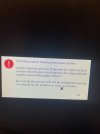
Spectrum scan now also works on tas2101 devices. The spectrum has poor resolution compared to stid135. To avoid misunderstandings: the
graph does NOT show results of blindscan, just an estimate of possible mux frequencies and their bandwidth. These values will be used
as initial guesses when pressing the tune button. If "blindscan" is on, the tuner will then find the correct values. Providing initial guesses helps
the tuner to find a lock, although in theory it is not needed.
In this example, a peak was found at 11423V with an initiial estimate of symbolrate of around 23500. After tuning,
the correct info is found in two ways:
- "info from tuner" shows the frequency actuallt locked into: 11 426.586MHz, and the symbol rate locked onto: 29500, which is rather different from the initial guess, because the initial guess is poor because of teh poor tuner resolution. The initial guess can also be poor due to other reasons, such as low SNR (weak satellites).
- "NiT-actual" (on the left): shows what is reported by the broadcaster in the SI info of the stream: frequency is 11 426.5 Mhz, which is slightly off compared to what the tuner reports, but symbolrate typically agrees (very) well.
The difference between correct frequency (11 426.5) and tuned frequency is due to two causes: inaccurate local oscillator of LNB (main cause: can amount to 1 or 2 Mhz with some LNBs) and inaccuracies in the tuner (higher for tas2101 than for stid 135, but small in both cases). NeumoDVB, which was used to create the screenshots, remembers these differences and learns to compensate for them. So after a while of use,
the frequency reported by the tuner will get closer to the true one. In the screen-shot, neumoDVB estimates that the LNB error in frequency is about 1.053 Mhz. The difference between 11 426.586MHz and 1 426.5 Mhz is only 86kHz because neumoDVB has compensated most of the error away.
The new driver code also correctly detects the "MATYPE" property of the stream, which means rolloff, multistream, ... are correctly detected
now. The reported RF dB values are also closer to the truth for the av201x tuner (existing code was wrong).
What is not implemented:
- blind searching the complete frequency band in the driver itself, which could be more accurate than "picking peaks from a coarse spectrum and asking the driver to tune them." The latter works perfectly on stid135 (high res spectrum), reasonably well on stv091x (decent resolution spectrum) and less well on tas2101.
- PLS/mulitstream




